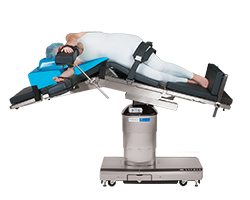The Ultimate Guide to the Lateral Position
What is the Lateral Position?

One of the four main surgical patient positions, the lateral position is used for procedures that require surgical access to one side of the patient’s body. In the lateral position, the patient lies on one side. Some common procedures that may require a patient to be positioned in the lateral position include back surgeries, lower extremity surgeries, thoracic surgeries, Ear Nose Throat (ENT) surgeries, and kidney surgeries.1
When Would You Put a Patient in the Lateral Position?
The lateral position is used for surgical access to the thorax, kidney, retroperitoneal space, and hip.2 Depending on the side of the body on which the patient is being operated, the patient will lie on their left or right side. Before being placed in the lateral position, the patient is induced in the supine position. A team of Operating Room staff will then lift and turn the patient onto their nonoperative side. The patient is placed into the supine position toward the edge of the operative side of the surgical table and then turned onto the side toward the center of the table.
When positioning a patient in the lateral position, surgical staff should use safe practices and guidelines.1,3 The following are to be used as appropriate based on individual patient variables and the procedure. Surgical staff should refer to their facility's positioning policies and procedures for the safe positioning of patients.
- Place a pillow or head positioner under the patient’s head with the dependent ear assessed after positioning.
- Support and secure the patient’s arms on parallel armboards with one arm on each armboard and both arms abducted less than 90 degrees.
- Place an axillary roll under the patient’s dependent thorax, distal to the axillary fold, at the level of the seventh to the ninth rib.
- Verify the patient’s bilateral radial pulses after placement of the axillary roll.
- Maintain the patient’s physiologic spinal and neck alignment.
- Flex the patient’s dependent leg at the hip and knee. (This is done for extra support during the procedure, to reduce the risk of the patient tilting and falling.)
- Position the patient’s upper leg straight and support it with pillows between the legs.
- Place safety straps across the patient’s hips.
- Use lateral braces, kidney braces and bean bag positioners as needed.
As with all surgical positions, surgical staff should be aware of risks to the patient in the lateral position.
Complications associated with lateral position include:1,3
- Pressure to structures on the dependent side of the patient’s body including the ears, shoulders, ribs, hips, greater femoral head, knees, and ankles – A pressure-reducing tabletop mattress or pad and additional padding should be used as needed.
- Brachial plexus injury – Place a padded roll under the lower axilla to reduce the risk of the patient suffering from a brachial plexus injury. The lower shoulder should be slightly forward with the lower arm placed on the armboard palm up. The upper arm should be supported and elevated on an armboard or pillows.
- Venous pooling – Interventions to safeguard against venous pooling include slow smooth postural transitions to diminish cardiovascular effects.
- Diminished lung capacity – Ventilator support includes positive end expiratory pressure (PEEP), and a double-lumen endotracheal tube to ventilate dependent lung if a thoracotomy is being performed.
Why Would You Place a Patient on the Left Side?
Depending on the side of the body on which the patient is being operated, the patient will lie on their left or right side. In the left lateral position, the patient lies on the left side of their body for a surgical procedure on their right side. For surgery on the left side of their body, the patient lies on the right side.
Alternate Positions to the Lateral Position
Variations of the lateral position include lateral kidney position, lateral chest position, lateral sims recumbent position, and lateral jackknife position. The lateral kidney position is commonly used for kidney surgeries. Lateral chest position is used for unilateral transthoracic procedures.
Lateral Position Supporting Devices
Anesthesia Armboards – Lightweight and carbon fiber, these Anesthesia Armboards are designed to allow access for anesthesia caregivers during a procedure while a patient is in the prone position. The Anesthesia Armboard easily attaches to any standard siderail with its integral attachment clamp and is enhanced for durability with protective edging to safeguard against damage.
Multi-Posture Armboard – The padded arm support constructed of lightweight carbon fiber provides versatile positioning for lateral, supine, prone, and seated patient postures. This armboard provides appropriate alignment of arms in the lateral position.
ELITE™ Lateral Positioner – This positioner permits a safe, quick, and easy transition from the supine position to the lateral position. The patient’s lower shoulder fits into the integral channel to provide exceptional patient comfort and nerve protection while in the lateral position. The built-in headrest and axillary support assists in proper spinal alignment and surgical site access.
ELITE™ Supine Headrest – This headrest can be used to support the patient’s head in both supine and lateral positions. The 3-dimensional cradling of the patient’s head provides volumetric redistribution of pressure to protect against the onset of pressure sores.
Foot Extension – The foot extension supports the patient’s feet when applied to general surgical tables in a perpendicular fashion. Footboards assist in preventing nerve damage and unintended patient movement in reverse Trendelenburg position.
Patient Restraint Strap – Patient Restraint Strap is a reinforced synthetic elastomer belt and strap with quick-release clamps for easy yet secure, adjustable positioning on the surgical table's siderails. The strap is compatible for use with all surgical tales and table extensions with siderails.
Conclusion
One of the four main patient positions, the lateral position provides access to the operative side of the patient’s body. Surgical staff should consider risks and complications associated with the lateral position such as pressure to structures of the dependent side of the body including the ears, shoulders, and ribs, brachial plexus injury, venous pooling, and diminished lung capacity.
Variations to the lateral position include the lateral kidney position, lateral chest position, and lateral jackknife position.
Regardless of what position is being used for a patient during a procedure, it’s important to follow best practices for positioning.1
- Have an adequate number of personnel, devices, and equipment available during positioning activities helps to ensure patient and personnel safety.
- Respect the patient’s dignity and privacy during positioning: Only necessary personnel in the room with the patient is exposed.
- Maintain the patient in a natural neutral alignment. Keep the patient’s head and neck is in a neutral position without extreme lateral rotation and avoid hyperextending.
- Verify the patient's complete body is in physiologic alignment and that the hands, fingers, feet, and toes are protected from surgical table articulations.
- Operating Room staff should always use safe body mechanics during transfers and positioning.
- Ensure that the patient is not in contact with any metal portions of the surgical table or positioning devices.
- Never exceed the weight limits for the table or the accessories used and always follow the manufacture’s guidelines and recommendations when using the surgical table and accessories.
- Inspect all equipment, pads and accessories and replace them as needed.
Contributors to This Article
Lena Elias-Fogle, BSN RN, CNOR
Director, Global Clinical Solutions
Lena is a seasoned healthcare leader with extensive experience leading complex perioperative environments as well as new program development, continuous process improvement, clinical outcomes, operational excellence, and stakeholder experience.
References
1 Guideline for positioning the patient. (2017). AORN Journal, 105(4), P8-P10. doi:10.1016/s0001-2092(17)30237-5
2 Positioning the Patient for Surgery. Jones & Bartlett Learning, LLC, an Ascend Learning Company.
3 Rothrock, J. C. (2011). Alexander's care of the patient in surgery (14th ed.). St. Louis, MO: Mosby.
 United States
United States
 Canada (EN)
Canada (EN) Canada (FR)
Canada (FR) Deutschland
Deutschland Italia
Italia United Kingdom
United Kingdom Australia
Australia New Zealand
New Zealand Singapore
Singapore Brasil
Brasil México
México



